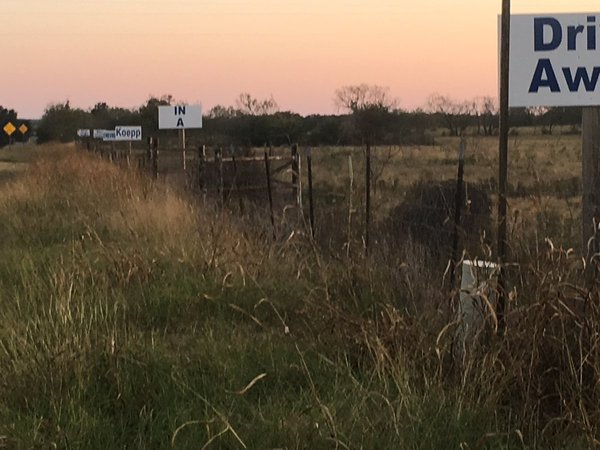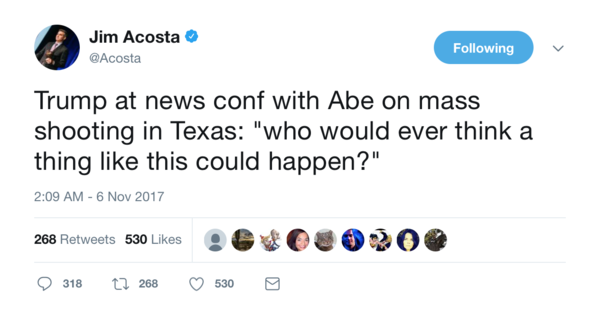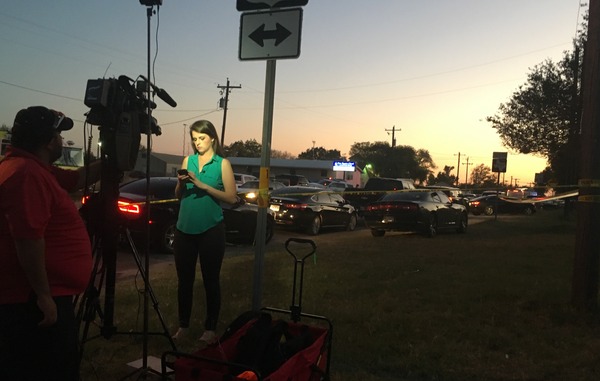The Profound, Dispiriting Strangeness of Covering a Mass Shooting
Photos by Roger Sollenberger
I’m typing this in my car at the crossroads where less than 12 hours ago a man opened fire at the First Baptist Church of Sutherland Springs, TX, with an AR-style assault rifle, killing at least 26 people and wounding at least 20 others. I’d parked under the town’s one orange blinking traffic light, now more or less boxed in by state troopers and news vans. Recently, the citizens of Wilson County had petitioned to turn that blinking orange light into a real traffic light, to cut down on the number of deadly accidents at the intersection. The group of troopers in front of me cleared away the barriers, cut the police tape, and let another portable morgue in.
Quickly, here’s what we know: The gunman, now positively identified as Devin Patrick Kelley, was a 26-year-old white man and Air Force veteran who lived in New Braunfels, TX, a suburb of San Antonio about 30 miles from Sutherland Springs. Thirty miles seems a long way, but the area is mostly ranch land with lots of open space, meaning big districts, and New Braunfels is close enough that some area families told me their kids had gone to high school with Kelley. There are churches in every direction, most of them bigger than First Baptist, the archetypal little white church, and the faith community here is scattered, but devout and close-knit. At the time of this writing we don’t know why Kelley targeted First Baptist, though reports said his wife had in the past taught Bible classes there.
We know Kelley served in the Air Force as a logistics specialist. He was stationed in New Mexico in 2010 but apparently never went on a combat tour. In 2012 he was court-martialed for assaulting his wife and their child. His wife divorced him and the Air Force discharged him for “bad conduct,” including 12 months confinement, after which he apparently moved back to Texas. He bought the semi-automatic rifle that he used to carry out the massacre from an Academy Sports store in San Antonio back in April 2016. Reportedly, he listed his years-old Colorado address on the background check form and claimed he didn’t have a disqualifying criminal record.
Is Devin Patrick Kelley a terrorist? In my book, hell fucking yes. But my book isn’t the FBI’s, and there’s no official word yet whether this killing fits their bill: “Perpetrated by individuals and/or groups inspired by or associated with primarily U.S.-based movements that espouse extremist ideologies of a political, religious, social, racial, or environmental nature.”
The truth is we don’t know much, and at this point we shouldn’t expect to know much, so we shouldn’t talk as if we know much. Earlier this year a black man “shot a bunch of white men in Fresno while yelling “Allahu Akbar,” and that wasn’t classified as terrorism. So beyond the facts that will slowly trickle out through every major outlet anyway, all I can convey to you here is my experience on the ground, which has been very, very sad, and very, very weird.
So then, this is what it’s like for a journalist who’s never covered a mass shooting to cover one of the worst mass shootings in American history, one month after the worst mass shooting in American history.
The Story
Two sources at the scene, both reliable but who would not go on record—meaning this account is nowhere near confirmed—told me Kelley wasn’t a member of the church but had family who were, and that they had word he’d killed his wife (and possibly their child) at home before going to Sutherland. (I’ll note that it’s not being reported where the gunman’s family was when he headed to First Baptist, or, strikingly, where they are now.) Police raided his home and blocked off access, although it’s unclear what that raid yielded.
The shooter’s neighbor, Mark Moravitz, told the San Antonio Express that Kelley was a “regular guy,” and that “the only thing unusual across the street is we hear a lot of gunfire, a lot of times at night. We hear gunfire a lot, but we’re out in the country.”
Kelley had dressed in black tactical gear and used a Ruger semi-automatic. He began shooting outside the church, then went in. A man who lived across the street heard the gunfire and, in top Texas form, came out with his rifle and shot at Kelley when he reappeared outside. Kelley apparently spooked, dropped his gun and drove off, and the other man, reportedly now with a second man riding shotgun, gave chase into neighboring Guadalupe County, where Kelley crashed his SUV. Kelley was found dead inside, apparently of a gunshot wound. Guadalupe Sheriff Arnold Zwicke told me they didn’t know if the gunshot was self-inflicted or came from the men who chased him. He said no law enforcement had been involved at any point up until then.
Kelley’s victims ranged in age from 5 to 72. One of them was the pastor’s 14-year-old daughter. The number of people killed or wounded amounts to about 12 percent of Sutherland Springs’s total population. The church typically videotapes its services and broadcasts them on YouTube. There are brains on Bibles.
Signs on the highway where Devin Kelley died escaping: “Drive away in a Koepp Chevrolet.”
The War Is Weird
At the roadside scene where Kelley died, I met an elder from another area church who was driving by with his family, on their way to be with their own church community. He had bristled hair and a bristled beard, like he just set his electric razor to number 3 and ran it all over his head. When I told him I was sorry for this tragedy but couldn’t quite seem to feel whatever it was I felt I was supposed to feel, he clasped his hands, very businesslike, and replied like he’d had the line ready: “You can’t reason with unreasonable things.” Then he got back in his SUV and headed off with his family to hold vigil at his church.
In the evening, the Sutherland Springs community held its own bluntly Christian candlelight vigil in front of the Post Office, just across the street from First Baptist. The church kept its blue marquee sign lit throughout the night. It hadn’t been updated from the week before: “Join Us, Fall Fest, Oct 31, 6 to 8 PM.”
It surprised me that so many people were so eager to share their perspective. A short, compact guy with a high-and-tight haircut and tactical glasses flagged me down. His name was Mike Gonzalez, and he was leading the vigil. Like everyone else, Gonzalez said he lived “nearby” (no one would say the name of whatever town they lived in; it was always “a couple miles that way” or “up the road over there”) and spoke with an aggressive hopefulness about how important faith and the church was to that community, and that they were all unified as one, “even though we’ve got a lot of different churches.” Gonzalez was a Marine, a member of the first unit to deploy “into the sand” in Afghanistan, and he said it made him “sick to his stomach” to think a veteran did this.
“We’re fighting the war over there,” he said. “Why are we bringing the war back here?”
I wondered: Is this a war?
The writer Lee Sandlin once pointed out that even the greatest WWII-era war reporters, guys like Ernie Pyle, couldn’t quite ever put their finger on what war actually was. They kept coming back to one word: “weird.” War is beyond words. At some point language fails and you end up coming back to stuff like “strange.” “Uncanny.” “Irrational.” “Weird.”
And yes, it’s definitely an unreasonable thing, and I’d call it fundamentally weird, to be reporting at the scene of the most deadly mass shooting in Texas history (and one of the most deadly mass shootings in the U.S.) only one month after the most deadly mass shooting in U.S. history.
It’s also fundamentally weird for a Guadalupe County Sheriff’s deputy to shrug and say, less than six hours after dozens of people were massacred a few miles away, “What can you do? There’ll be another one tomorrow, next week.”
It’s fundamentally weird for the President of the United States, who has lived in America for 71 years, to say this.
It’s fundamentally weird that, in contrast to the leader of the free world, Kyndle Prophit, a ten-year-old who lives near Sutherland Springs, told me, “These things can happen anywhere… I wonder why he didn’t keep driving, why it wasn’t my church. My church is much bigger.”
It’s fundamentally weird to see the professional dissociation of the media. Camera lights shoved into glazed faces. A young reporter on the fringe of a candlelight vigil, so mawkish by now, caking up her face by the light of her iPhone. Camera guys talking shop. Correspondents clustering around mourners like ants on a candy.
“It’s a waiting game,” a cameraman with a local Fox station told me as he waited behind a media barrier at the church for the bodies to be removed. They hadn’t been removed even when I left hours later, and he was still there, playing his game against the medical examiner who was playing his game against the bodies.
And what do those bodies look like? They look weird.
This looked weird.
It’s weird to watch reporters try to beat each other to teary faces. Then it’s weird to realize after a while that there actually aren’t all that many teary faces to beat each other to.
It was weird to have someone hand me a candle and light it for me, then have it dawn on me I was the only journalist holding a candle. I scorned the press. At what point do you give in and join with other humans? That’s the story, too, yes?
Maybe?
Every reporter I’d spoken with had covered a mass shooting. Virginia Tech, Aurora, the shootings in Texas, Washington state, etc. One reporter who was 33, two years younger than me, had already covered three. John Anthony Salazar, a San Antonio-based reporter with Spectrum News, seemed baffled that I even approached him with the question.
“No, I don’t have any emotions,” he said. “A few days later, yeah, I’ll cry. Or I’ll bottle it up, drink whiskey. But right now you’re here and you detach and do it, because it’s the job you’re trained to do.”
I asked how many mass shootings he’d reported. “All of them,” he said. Meaning, I gathered, all of them in Texas, such as Ft. Hood (both times) and the Dallas police shooting. When I said I’d never been in such a position and found it simply too weird to process, he told me about the first body he’d seen on the job, back in 1997, at the scene of a fatal wreck: An EMT had a ventilator on a young man who was clearly dying, and the EMT, an old hand, kept trying to prop up the man’s head so he wouldn’t look terrible for the camera. He’d prop up the head, it’d roll back. He’d prop it up, it’d roll back. Salazar watched the man die there, and he got paid for it.
But it’s also fundamentally weird to watch some of these mourners, these devout people gathered in front of the Post Office, swaying to anthemic Christian pop worship songs, hands up to praise the same god that was watching their neighbors when this blackest of mornings played out across the street, shot by shot.
I’d say it’s fundamentally weird to invoke god at all.
Candles versus Cameras
At the end of the vigil, a Charlie Daniels-looking dude with a biker beard and a white cowboy hat took over. His name was Stephen Curry (yeah), Pastor of nearby La Vernia United Methodist Church, and when I later pulled him aside to ask about how he and so many others were able to draw on their faith after this, he explained that the Christian view is that the world is already fallen, is already sin.
“Acts like this aren’t unexpected,” he said. “In fact, it’s part of what we’re called to address.”
And there you have it: Do your job. On one side the candles, on the other the cameras.
In a sense it doesn’t matter what the story is, why someone would do what Devin Patrick Kelley did. You can’t understand it. Even if Kelley came back from the dead and told you exactly why he did it, you’d still never understand it. So it becomes simple: You can only do your job. The media had its professional duty to get the fullest and truest story on the record, and the mourners had their spiritual calling. In one light they all seemed out of touch, but then again I couldn’t get in touch: Across the street, a five-year-old’s body had bled out and stiffened. Across the street, Bibles covered in brains.
You can’t reason with an unreasonable thing.
But you sure as shit can make it prohibitively expensive to purchase high-capacity magazines.
You can’t do anything about what happened, so do your job. Sure, there’s an emotional dimension we all must respect and wrangle with in our own ways, but the only way we’ll ever get beyond senselessness is to be sensible, to do our duty. It’s not callous, then, for lawmakers or U.S. citizens to demand laws that make it next to impossible for a person to acquire the kind of absurd firepower that allowed Devin Patrick Kelley to mow dozens of people down in that narrow room yesterday morning. To make it impossible for someone to do what Stephen Paddock did in Las Vegas last month, and put a bullet in one person every second for ten minutes straight.
So yeah, I’m politicizing it: Don’t try to ban guns. Ban high-capacity magazines. From 1994 to 2004, we banned assault weapons and high-capacity magazines. It didn’t do much to the murder rate, but it affected the mass shootings. In the chart I’m about to link, notice what happened between ‘94 and ‘04: The massacres all but stopped, with Columbine being the one tragic exception. Then look what happened from 2005 onward.
It’s insane, time and again, to offer thoughts and prayers for these massacres. To say, as our president did, “May God be with the people of Sutherland Springs.” It was in a church. And it’s insane to stand across the street from that church with your hand in the air, praising the good god you believed watched the slaughter unfold in his house and did nothing about it.
Thoughts and prayers can do one thing. But they don’t do everything. We can be two types of people at once.
At the end of the vigil, they held a moment of silence. A woman who had known the shooter reached out for my hand, and I took hers. A reporter beside me turned and walked away. After a few moments I leaned over to the woman and said, “Forgive me, but I’ve got to let go.” She nodded and let go of my hand, and I covered my eyes and walked back to where the cameras were.


